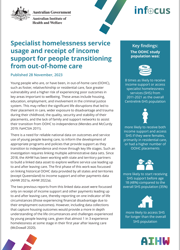Summary
Understanding the extent of a person’s service usage, and the different types of services they are engaging with, can provide insights into their level of need and life circumstances at the time of support. To date, this project has explored the patterns of income support receipt of young people transitioning from out-of-home care (OOHC). It has shown the OOHC study population (defined as young people born between 1 July 1990 and 30 June 2001, who had at least one OOHC placement lasting 7 or more days) were more likely to receive income support across all ages from 16 to 30, and for longer periods of time, compared to the Australian population of the same age (AIHW 2021a, AIHW 2022a). It also found that the OOHC study population repeatedly moved in and out of income support into their late 20’s, while for the Australian population of the same age, income support receipt was for shorter periods of time (associated with key life stages such as pursuing further education or training or starting a family), rather than ongoing support.
Focusing on the type of payments received can provide further insights into a recipient’s life circumstances at the time of receipt. For example, payment receipt might suggest that someone is struggling to secure ongoing or sufficient employment, unable to work due to caring responsibilities or disability, or undertaking studies . Analysis from the previous reports highlighted a decline in overall income support receipt between ages 16 to 30, which was driven by a decline in receipt of student and unemployment payments. However, parenting, housing, and disability related payments increased steadily up to the age of 30. This reflects the changing needs and circumstances of people who have left care as they get older.
Building on these findings, this report has shown that 9 in 10 (89%) of the OOHC study population received either Specialist Homelessness Services (SHS) support or income support at some point in the observation period (2011–2021). It further highlighted that the OOHC population were were far more likely (8.1 times as likely) to receive both SHS and income support compared with the overall Centrelink-SHS population[1] of the same age (46% vs 6%). This may reflect the financial vulnerability of SHS clients or that through engaging with one service, a client becomes more aware of, and better connected with, other services. Indeed, one of the specific services that SHS agencies provide is support to obtain and maintain government allowances.
The OOHC study population also tended to receive SHS support from younger ages (often whilst still in care) and for longer periods of time, compared to the overall SHS population. This includes housing and accommodation services, but also a range of other specialist services. The OOHC study population who received SHS support were more likely to be in need of every specialist service type – particularly drug and alcohol, family, mental health and disability services – compared with the overall SHS population. This reflects their complex needs and multiple disadvantages.
This report goes some way in helping to understand the pathways of young people as they transition from OOHC into adulthood. The findings presented in this report, however, do not imply causation between a child’s time in OOHC and their subsequent receipt of income support or specialist homelessness services. These children may be affected by complex circumstances that contribute to their placement in OOHC, and which may also influence their need for further services. Further, the characteristics of children who experience OOHC are quite different to those of other populations of the same age, which may influence receipt of income support based on eligibility requirements for these payments (see Appendix for further details). These factors should be taken into consideration when drawing inferences in relation to the OOHC study population and other populations of the same age.
Note some of the analysis in this report examines service usage across the entire observation period, from 2011-2021. For these analyses, each person in the population will be counted once. Other analyses, including where results are presented by age, examine service usage within a particular year. In these cases, people are counted at each age they received a service within the observation period, and may be counted at more than one age. See the Appendix, and the footnotes for each figure, for more detail on methodology.
[1] The overall Centrelink-SHS population includes people who received an income support or other payment in their own right as well as those known to Centrelink through a relative’s application, and/or people receiving SHS services. It is likely that the vast majority of people from the Australian population in our age range of interest are captured in this population. See the Appendix for more details.
- Summary
- Key findings
- Services received by the OOHC study population
- Homelessness services needed
- Main reasons for accessing homelessness service
- Duration of support from services
- Differences in OOHC characteristics for those receiving SHS and income support
- End matter: References; Acknowledgements; Appendix; Glossary



